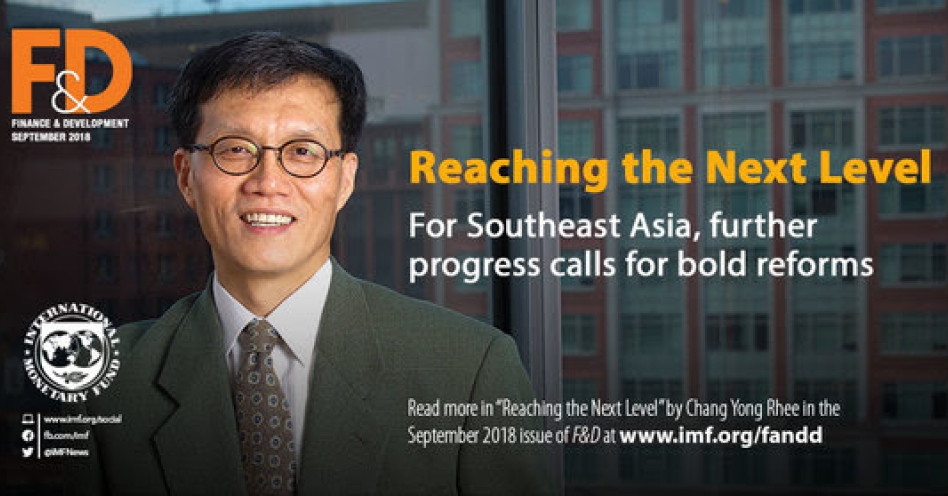Reaching the next level: For Southeast Asia, further progress calls for bold reforms
Article By: CHANG YONG RHEE, director of the IMF’s Asia and Pacific Department

SOUTHEAST ASIA HAS made extraordinary strides in recent decades. Growth in per capita incomes has been among the fastest in the world, and last year the region was the fourth largest contributor to global growth after China, India, and the United States. Living standards have improved dramatically. Poverty rates are down sharply.
What accounts for this record of success? Openness to overseas trade and investment is a big part of the answer. Malaysia and Thailand have established themselves as global manufacturing powerhouses, churning out cars, consumer electronics, and computer chips. Indonesia and the Philippines are among the world’s fastest-growing large, domestic-demand-led emerging markets. Singapore is a major financial and commercial hub. Frontier economies such as Cambodia, Lao P.D.R, Myanmar, and Vietnam are exiting from decades of central planning after joining the Association of Southeast Asian Nations (ASEAN) and integrating with regional supply chains, particularly in China.
Sound economic management has also played a vital role. To be sure, the Asian crisis of 1997 was a setback, but Southeast Asia bounced back quickly and emerged stronger. Banks were restructured and financial regulation strengthened. Local currency bond markets were deepened to reduce dependence on volatile capital flows. Rising prices and credit growth were brought under control as some countries moved toward adopting inflation targets and so-called macroprudential policies, which are designed to monitor and prevent risks to the financial system.
As a result, the region weathered the global financial crisis, but it will need to further strengthen its economies to handle short-term challenges, such as rising interest rates in the United States and other advanced economies, growing trade tensions, and slowing growth in China. It all adds up to greater uncertainty and more market turbulence for increasingly interdependent economies that have accumulated more debt.
Fundamental forces
In the longer term, though, more fundamental forces will test ASEAN leaders and populations. While Southeast Asia has significantly narrowed the gap separating it from the world’s richest nations, further progress is not preordained. The region cannot afford to rest easy; rising to the next level will call for a mutually reinforcing set of bold reforms.
Shifting demographics loom large among the coming challenges. In recent decades, the number of workers grew faster than the number of dependents, providing an impetus to economic growth. That demographic dividend is now starting to wane. The working-age population continues to grow in Indonesia and the Philippines, but it is projected to shrink rapidly in other countries, including Thailand and Vietnam. Simply put, Southeast Asia risks growing old before it grows rich.
In response, Southeast Asian nations will have to beef up their pension systems and social safety nets to care for the growing ranks of older citizens. Bringing more people into the labor force, especially women, will help keep the growth engine humming. With notable exceptions, such as in Vietnam, female labor participation rates remain low across Southeast Asia. Providing child care and flexible working arrangements can encourage more women to work.
Skills needed
Waning productivity growth is another obstacle. More advanced ASEAN economies are starting to lose some of their competitive advantage as wages rise. At the same time, automation and robotics are reducing demand for relatively unskilled labor; increasingly, manufacturing will require fewer, better-educated workers. To move beyond middle- income status, the region will no longer be able to depend on the existing growth model of labor-intensive manufacturing for export.
Advances in artificial intelligence and machine learning, while creating opportunities, present additional challenges. Workers will need education and training to prepare for the jobs of the digital age. Governments should also improve the business environment by investing more in research and development and upgrading roads, ports, and broadband infrastructure.
Of course, all this requires money. Taxes as a proportion of GDP, at 13 percent, are below the global average of over 15 percent. That will have to change if the region is to finance essential investments, unlock productivity growth, and prepare for an aging population. But raising more money won’t be enough: strong policies and institutions will be needed to make sure that precious taxpayer money is spent wisely.
As trade patterns and technology reshape the competitive landscape, Southeast Asia will have to rely more on domestic demand and less on sales of goods outside the region. To that end, further integration will be needed. ASEAN has significantly reduced tariff barriers to trade in manufactured goods; it should further reduce trade costs and open its markets more fully to trade in services and the movement of labor.
The goal of completing an ASEAN trade in services agreement by 2025 will be a big step. If living standards are to rise further, the region cannot rely indefinitely on low-wage, low-skill service jobs in corner shops and restaurants; it will have to train more scientists and programmers, as well as professionals such as home health aides to care for the elderly. Investing more in its people and opening markets to expertise and technologies from abroad would advance that goal.
Of course, we must always remember that the goal of rapid growth is to improve living standards for the many, not the few. To be sustainable and command broad social support, economic policies must ensure inclusive growth. Governments should strengthen social safety nets, encourage competition, and challenge entrenched interests.
The region has made huge strides since the founding of ASEAN more than half a century ago, but significant challenges remain. Thankfully, with the right policies, Southeast Asia can rely on the creativity, resilience, and dynamism of its people to meet those challenges. The IMF has been an important partner in the region’s development, and it stands ready to continue serving its Southeast Asian members in the future.
Editor's Note: This article was first published by the International Monetary Fund





















